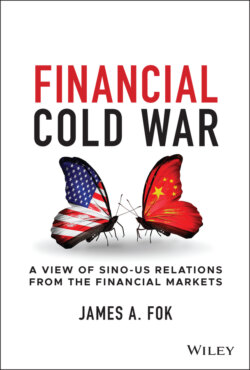Читать книгу Financial Cold War - James A. Fok - Страница 18
Chapter 2 How the US Dollar Took Over the World
ОглавлениеDollar bills have absolutely no value except in our collective imagination, but everyone believes in the dollar bill.
– Yuval Noah Harari
If we were to imagine the global economy as a human body, then you could say that America controls its circulatory system. Flowing through the arteries and veins of the global financial system are US dollars, which serve as the primary means of exchange in international trade and investment, and as a universally recognised store of economic value. The dollar was used for around 39 percent of all global payments and dollar-denominated securities (largely in the form of US Treasuries) made up roughly 60 percent of global foreign exchange reserves in 2020,1 far exceeding America's share of either world trade (11 percent2) or nominal global GDP (24 percent3). In other words, the US currency plays a role in the world that stretches way beyond US borders and has, in effect, become a global utility.
At least one former US Treasury Secretary has acknowledged that the dollar's role is a source of great power for the US, since it has allowed the US government to ‘pay lower rates … than it otherwise would’ on its borrowings and ‘enables the country to run larger trade deficits, reduces exchange-rate risk, and makes American financial markets more liquid’.4 Another commentator put it more bluntly: ‘By generating a steady flow of customers who want to hold the currency … it allows the privileged country to … fund a lifestyle well beyond its means’.5
At one time, the dollar was backed by a fixed quantity of gold; however, since President Nixon's abandonment of the gold standard in 1973, the currency has had no intrinsic value beyond ink, paper and faith in the US government and its financial system. That the rest of the world continues to confer what former French president Valéry Giscard d'Estaing called this ‘exorbitant privilege’ on the US undoubtedly reflects the fact that the dollar-based global financial system has had benefits for other countries as well. However, as we shall see in Chapter 3, many stakeholders within that system are increasingly questioning whether the costs may now outweigh the benefits.
Although it seems firmly entrenched, the primacy that the dollar enjoys today is, in historical terms, a relatively recent phenomenon. For most of the 1800s, America's economy was predominantly agrarian and inward looking. It was not until 1916, with Europe heavily weighed down by World War I (WW1), that the US economy overtook the British Empire to become the largest in the world.6 Even then, the role the dollar played in global trade and investment was only roughly equivalent to that of sterling up until WW2 and the throbbing heart of international finance continued to be the City of London, whose banking fraternity looked down on their US counterparts as ‘unsophisticated kinsmen, too rich for their own good’.7
While it may be tempting to draw a correlation between the growth of the US economy during and after WW2 and the rise in the dollar's global status, much as it is now speculated that China's economic growth will inevitably lead to the renminbi becoming the dominant global currency, this interpretation would be overly simplistic and inaccurate. If GDP size were the sole factor determining the relative global importance of a nation's currency, then both the euro and the renminbi would already be close to usurping the dollar – a prospect that remains distant today. Instead, the dollar's present dominance is rooted in historical circumstance and perpetuated through four pillars of the US system: the rule of law; international trade and macroeconomic policies; the deepest and most open financial markets in the world; and established capital markets infrastructure supporting the global financial system. All too often, this fourth pillar is overlooked by economists and policymakers. This is a serious oversight for, without a solid understanding and appreciation of the ‘plumbing’ of the global financial system, it is impossible to foresee the impact of market evolutions or to design effective financial policies. Before attempting to diagnose the problems of our current global financial order, let alone determining the feasibility – or even desirability – of any major changes to it, we must first understand how it came about and its structural underpinnings.
The story of the US dollar's rise over the last century is inextricably intertwined with the geopolitics of the era, but it is also one of financial and technological innovation. At certain times, domestic and international policies drove this innovation; at other times, geopolitics were driven by structural shifts in the markets. Some significant factors that contributed to the dollar's dominance actually arose out of American policy mistakes, policy choices by other governments, or financial entrepreneurialism that policymakers initially weren't even aware of. There are, of course, many aspects to American power besides the dollar, and the currency has always had a relationship of symbiosis and mutual reinforcement with these. However, as the other sources of US power have waned, the dollar has become ever more important in relative and, paradoxically, absolute terms. There has been a price for this though – one that the original architect of the dollar's leadership perhaps didn't sufficiently take into account.
